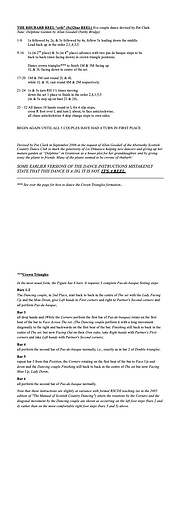



WELCOME TO An Entertainment Site for Scottish Country Dancers - Enjoy the curated selection of theme-related dances for celebrations and holidays, or find a dance associated with a special calendar day, or EVEN your own birthday!
Strawberry Rhubarb Pie Day
Jun 9
Other Scottish Country Dances for this Day
Today's Musings, History & Folklore
"Don't fear the rhubarb!"
~ apologies to the Blue Oyster Cult
Loved or hated (or feared), rhubarb was introduced to Europe in the 1600s and became popular for its beautifully pink color and tart taste, culminating in the invention of the classic strawberry-rhubarb pie. Rhubarb is often viewed suspiciously by those who have heard about its poisonous nature, though it is only the leaves that contain toxic compounds, while the fresh stalks can be eaten raw or boiled. Interestingly, the word rhubarb itself has been imbued with all sorts of slang meanings, particularly in the world of baseball and in the theater! On the stage, the word "rhubarb" is sometimes used to represent low-level conversation or the noise of a crowd. Supposedly, extras onstage would intone “rhubarb, rhubarb, rhubarb” to simulate the muttering of crowds, particularly angry muttering! 🥧
The Rhubarb Reel
Rhubarb pie and treats have been popular in the UK where it was cultivated since its introduction to Europe from China (attributed to Marco Polo) in the 1600s. The strawberry-rhubarb pie is a favored variation in which the strawberries (and lots of sugar) help balance the natural tartness of the rhubarb.
The genesis of the word “rhubarb” comes from its presence along the banks of the Volga River in Siberia; it is a combination of “Rha” (the Greek word for the Volga) and the word “barbarum,” or barbarian/foreign.
Benjamin Franklin is credited with sending rhubarb seeds to America from England where it became widely cultivated. Rhubarb pie was so popular with pioneer generations that the plant was called "pie plant." The pie figures in sentimental and nostalgic novels taking place from the Civil War through World War II. Although it's botanically a vegetable, it became officially a fruit in the U.S. in 1947, when a New York court reasoned that it was used mostly for desserts, and therefore was a fruit. Everywhere else, it's considered a vegetable. Go figure!
Only the stalks of the rhubarb are used, because Rhubarb leaves contain poisonous substances, including oxalic acid, which is a nephrotoxic and corrosive acid. Frostbitten stalks are also avoided since they maintain toxicity.
The expression "Do you think the rain will hurt the rhubarb?" is a stock phrase used to signify a "deliberate turning to an innocuous topic of conversation (the weather) - when one doesn't wish to comment on a small social outrage deemed to be apparent to anyone of sense."
Interestingly, the word rhubarb itself has been imbued with all sorts of slang meanings, particularly in the world of baseball and in the theater.
The word "rhubarb" is sometimes used by actors to represent the conversation or the noise of a crowd. Supposedly, extras onstage would intone “rhubarb, rhubarb, rhubarb” to simulate muttering, particularly angry muttering.
For the dance cribs and more on the extensive slang meanings of the word "rhubarb," click the vintage can label.
And though everyone has their own favorite, click here for an excellent recipe (using brown sugar and orange juice) with beautiful photographs from Sally's Baking Addiction for a traditional lattice-top version.
Or for a strawberry-rhubarb crostata shown below, click!
Click the dance cribs or description below to link to a printable version of the dance!



